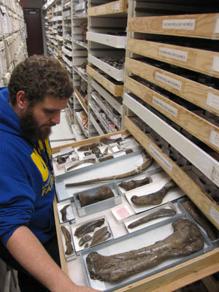Collection

The Earth Science Collection was created as a result of the pioneering efforts of naturalist, Otto W. Geist. Geist collected thousands of paleontological specimens on multiple expeditions throughout Alaska from the 1920's to the 1950's. Since then, the collection has grown significantly through acquisitions resulting from research projects and donations. Currently, the Earth Science collection oversees approximately 65,000 specimens, subdivided into Paleontology and Geology collections.
The Paleontology Collection houses both vertebrate and invertebrate specimens ranging from Cambrian archaeocyathids
to Ice Age Mammoths. Significantly, it includes the largest collection of polar dinosaurs
in the world (primarily from the North Slope of Alaska) and a diverse assortment of
Quaternary mammals. The collection also contains a variety of paleobotanical specimens
and a large collection of invertebrates (both micro- and macrofossils).
The Geology Collection includes minerals and gems from Alaska and around the world. It houses placer gold fines and nuggets, including spectacular native gold specimens on display as part of the C. J. Berry Gold Exhibit - the largest gold nugget exhibit in the state. The collection has a variety of examples of metamorphic, igneous, and sedimentary rocks documenting the fascinating geologic history of Alaska. The Geology Collection also has out-of-this-world specimens, such as meteorites and tektites, collected within Alaska and elsewhere.
Collection Policies
- Collection and Acquisition
It is the policy of the Earth Science Department to acquire and develop collections
and objects in accordance with the University of Alaska Museum of the North's mission
statement. The following is an extraction of key policies:
1. Future development of collections will concentrate on the fossil and physical geologic
record of Alaska, North America, and the circum-arctic regions.
2. The primary guiding policy shall stress acquisition of specimens through cooperative
joint ventures and Memoranda of Understandings with agencies of the Alaskan government,
federal agencies operating in Alaska, and private companies and corporations operating
in the state. This shall also pertain to foreign governments.
3. The purchase of collections or objects should be avoided. The curator shall always
pursue alternate means of acquirement such as exchange or donation whenever they are
clearly not precluded.
- Appraisal
No curator, or other employee or the University of Alaska Museum of the North, shall
participate in the appraisal or estimation of the value of an item, or collection
either as a service to the public, or as a precondition for donation.
All potential donors shall be informed that appraisals should be obtained prior to
making a donation. The curator in charge of the department receiving a donation must
have a properly certified appraisal in hand prior to completion of the Deed of Gift
form and official transfer of title.
Nothing in this policy precludes the curator from obtaining insurance of other appropriate
appraisals of collections or objects held by the museum.
- Ivory Collection
The University of Alaska Museum of the North has an extensive collection of ivory.
These specimens are in the form of raw ivory and artifacts or objects made from ivory.
The ivory comes from both fossil and modern sources, both terrestrial and marine environments.
In all cases the museum and the Earth Science department are acutely aware of their
role in discouraging the trade in antiquities and illegal ivory.
The Earth Science department does not participate in the appraisal, purchase, or sale
of modern ivory. In addition, the department does not engage in the appraisal or sale
of fossil ivory, and will only purchase fossil ivory if ownership and provenance can
be fully documented by the seller prior to the purchase. Fossil ivory should only
be purchased by the department when it can be determined that said ivory is of major
significance in regards to the existing collection or is of particular importance
to planned or existing exhibits. In all cases, the curator shall make a written recommendation
of purchase that is subject to final approval by the director of the museum.
The museum and the Earth Science department take an active part in the education of
the public to prevent the misuse and destruction of scientific sites.
